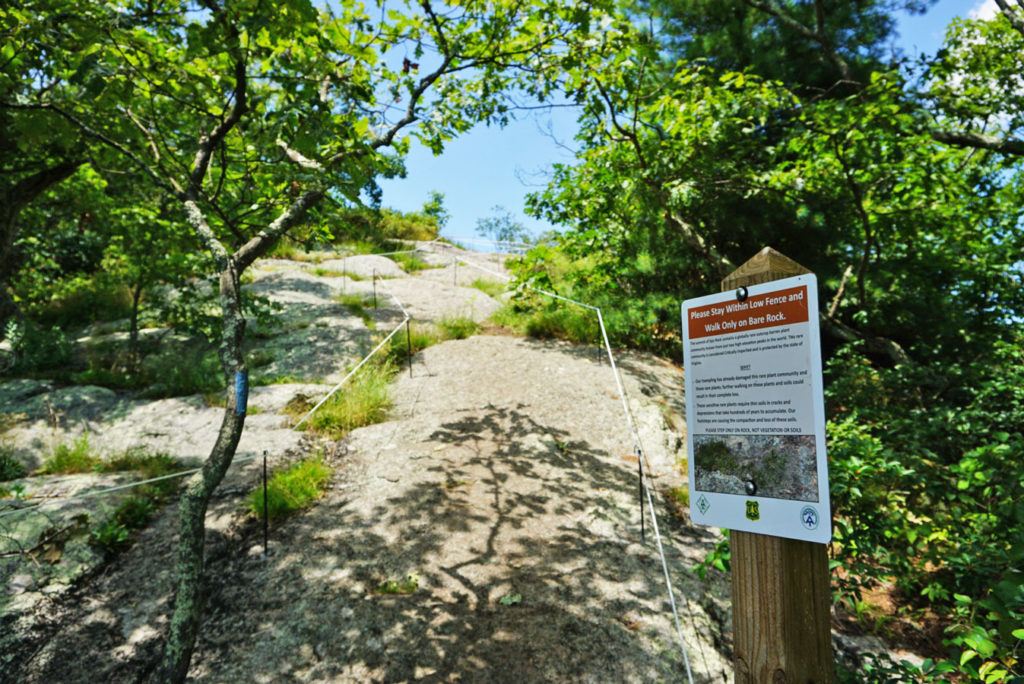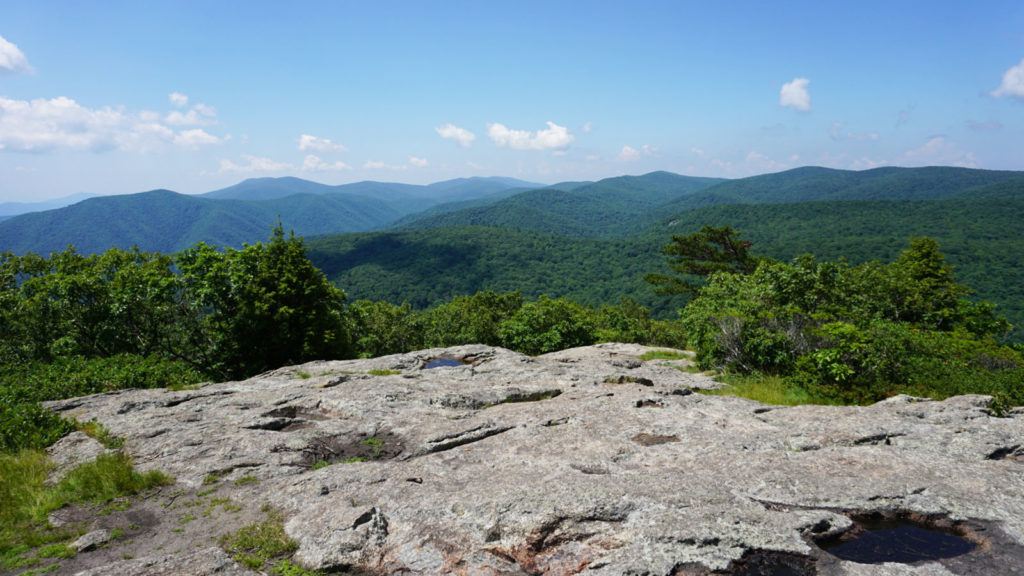The Preservation of Spy Rock
Nov 6, 2019

Nov 6, 2019

When I meet long-distance Appalachian Trail (A.T.) hikers in central Virginia, sometimes I get a crazy, urgent look in my eye and tell them that they MUST NOT miss Spy Rock. That’s because, on my thru hike in 2006, I saw the side trail to a viewpoint… and decided not to add any extra footsteps to my day. Eight years later, I finally took that side trail and realized what a mistake I had made. The 360-degree view from atop the granite dome of Spy Rock was absolutely breathtaking.
Unfortunately for some fragile, rare plants that call Spy Rock home, I’m not the only one recommending this hike lately. In recent years, Spy Rock has been the victim of what some land managers are calling “the Instagram effect” — lesser-known landmarks that get an unexpected spike in visitation after dazzling images are shared on social media. While it’s great to see people enjoying nature, these sites lack the facilities — from parking and bathrooms to durable trails and tent sites — to concentrate the impacts of a sudden influx of visitors.
At Spy Rock, a marked increase in day hikers and overnight campers had major impacts on the vegetation — some obvious, others less so. At the base of the rock, Appalachian Trail Conservancy (ATC) Ridgerunners and local trail maintainers watched fire rings pop up as the native undergrowth disappeared into a landscape of patchy grass and rhododendron stumps scarred by hatchets. Even worse, a maze of unsightly and dangerous social trails wrapped around the rock itself. The side trail ended at the base of the huge granite dome, and there was no designated route to the top of Spy Rock for the views. Visitors scrambling to the top often pulled plants out of the thin soil in search of handholds.

Greenland Stitchwort
The Greenland stitchwort (pictured above) and three-leaved cinquefoil both call Spy Rock home, but the increase in traffic has placed these already-rare plants at risk of being eradicated in the area.
The final straw that spurred ATC and our partners to action was much less visible. Over the last decade, volunteers with the Natural Bridge Appalachian Trail Club (NBATC) monitored an alarming decline in the populations of two rare alpine plant species on top of Spy Rock. Their reports became the impetus for a meeting and survey to assess Spy Rock. In 2017, ATC’s Conner McBane, Laura Neal of NBATC, U.S. Forest Service Botanist Fred Huber and Natural Heritage ecologists from the Virginia Department of Conservation and Recreation, Gary Fleming and Karen Patterson, visited the site to survey the damage.
Since the Virginia Department of Conservation and Recreation (DCR) last surveyed the plants in 1992, both populations had declined dramatically. Minuartia groenlandica (Greenland stitchwort) and Sibbaldiopsis tridentata (three-leaved cinquefoil) grow in the crevices of high-elevation exposed bedrock. One is only found in two other places in Virginia and the plant community is considered “Critically Imperiled” at a global scale. The other has been reduced to just a few small individuals and was “certain to be extirpated [rooted out and destroyed completely] unless immediate and strong measures are taken to protect it,’ according to the DCR report. It took centuries for the small pockets of soil these plants call home to form atop Spy Rock, and the plants themselves grow extremely slowly. These tiny plants have evolved to withstand intense exposure to sun, wind and weather.
There’s one thing they’re not tough enough for, however: soil compaction. Just a few human footsteps wandering about the 5-acre open rock summit can compact the soil and kill the plants.
How can we save these special plants while still allowing visitors to enjoy the views I so fervently warn hikers not to miss? ATC, NBATC and our USFS partners in the Glenwood Pedlar Ranger District collaborated on a management plan. A route was scouted and approved to extend the side trail to the top of the rock, which would be challenging, technical trail-building due to the thin soil and sloping bedrock. However, if it could be built and blazed, hikers would have one easy, obvious route to the summit and back.
That wouldn’t save the rare plants, though. To the untrained eye, the summit was a vast expanse of bare rock with a few patches of dirt and grass just calling out for a picnic blanket. Everyone loves to wander around and find their own spot — how could we keep them off the plants?

Through a collaboration between the ATC, Natural Bridge Appalachian Trail Club (NBATC) and the U.S. Forest Service, a new, sustainable trail was built to the top of Spy Rock, helping hikers reach the summit without impacting the fragile surrounding environment.
Learning from other high-use areas with rare alpine plants, including the A.T. in New Hampshire and Acadia National Park in Maine, the partners agreed on a plan to delineate a clear route to the very best view with a knee-high rope held up by a series of posts. The ropes on either side of the route open up at the top so hikers can still explore and enjoy a large area of bare rock, but they would have to go out of their way to step over the rope and trample the rare plants. Interpretive signage at the parking lot, near the A.T./side trail junction, and on the route near the top of Spy Rock explains the fragile nature of the plant communities and urges visitors to stay on the blazed trail and bare rock.
Due to the pressing nature of the problem, the 2019 schedule for the Konnarock Volunteer Trail Crew was rearranged to include three weeks of trail building at Spy Rock this July and August. U.S. Forest Service personnel and NBATC volunteers coordinated to install the interpretive signs, posts and rope at the same time the Konnarock Crew started building the trail. NBATC volunteers worked alongside the Konnarock Crew all three weeks and kept morale high by providing much-appreciated barbecue dinners and after-work trips to a secret swimming hole.

Interpretive signs and rope guides were installed to inform visitors about the rare plants in the area and to steer hikers onto a sustainable walking path.
From drilling into bedrock to pin rocks in place with rebar, to peeling and splitting locust logs for steps, to crushing smaller rocks into gravel with a sledgehammer, over 1,400 hours of volunteer sweat equity went into the construction of a backcountry engineering marvel. The solid new trail is 2,200 feet long and includes 21 rock steps, 37 log steps and 73 feet of rock cribbing. In addition to being safer, the new trail is more scenic since a small area along the route was cleared to open up views of the Old Campbell farm. Spy Rock is now an official blue-blazed A.T. side trail.
This project was a prime example of A.T. partnership at its finest.
“Without the assistance of neighboring clubs, RATC and PATC, the USFS, and Virginia DCR, this project would not have happened,” said Trudy Phillips of NBATC. “This project pushed the limits on NBATC, Konnarock, ATC, USFS, and NPS-APPA, and we all came out winners.”

Spy Rock visitors can now enjoy views from the summit while helping preserve the native species and reduce their impact on the surrounding environment.
Will the side trail extension, the guidance ropes and the interpretive signage be enough to protect the rare plants from trampling? Will visitors respect the new route or step around the barriers to walk and camp wherever they please? Only time will tell if the plants fully recover from the impacts that have been caused from heavy visitor use, but the strong partnership between ATC, NBATC, USFS and the Virginia DCR is sure to help us proactively manage issues at Spy Rock and beyond in the years to come.
“The engagement by all of the partners in this project resulted in an innovative combination of solutions that protected the rare plant community and, by improving the trail, also enhanced the recreational experience,” said District Ranger Lauren Stull. “The Glenwood & Pedlar Ranger District is grateful for the enthusiasm, expertise and capacity that our partners brought to this project.”



All gifts matched by a group of generous Trail Crew Alumni. Make your DOUBLED gift now!
Donate TodayGet the latest A.T. news, events, merchandise, and sneak peeks delivered directly to your inbox.